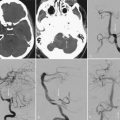CHAPTER 95 Brain Tumors
General Considerations
In the absence of known risk factors underlying the genesis of the majority of brain tumors, understanding their molecular oncogenesis takes on primary importance. To this end, the development of several animal models has provided specific clues about the formation of gliomas, medulloblastomas, and neurofibromas. Such animal models are also beneficial for testing molecularly targeted small molecules, signal transduction modulators, and other therapies such as those based on immunity and biologic agents (gene, viruses). There has also been the recent discovery that tumors may be composed of a subpopulation of self-renewing progenitor cells (“stem-like” cells) that are the main culprits of resistance to treatment and may perhaps be susceptible to altogether different treatment strategies. Other molecularly based discoveries are improving our ability to classify brain tumors and better predict their clinical course and response to therapy. One example that has entered routine clinical use is that of oligodendrogliomas that harbor deletions at chromosome segments 1p and 19q. Patients with both these deletions respond better and live much longer than those without both deletions.1 Another advance has been the improved median survivorship of patients with glioblastoma treated with the combination of temozolomide and radiotherapy and the subsequent correlation of hypermethylation of the promoter for the gene encoding methylguanine methyltransferase (MGMT) in glioblastomas with improved response to temozolomide and radiotherapy.2,3 In fact, almost half of this subpopulation of malignant glioma patients was alive at 2 years, an impressive result considering that previous median survivorships were thought to be less than a year! The significance of knowledge gained by understanding signal transduction pathways related to tumorigenesis is underscored by the finding that only patients whose glioblastoma tumors coexpressed the gene for the variant III form of the epidermal growth factor receptor (EGFRvIII) and the tumor suppressor gene PTEN were responsive to erlotinib, an EGFR kinase inhibitor.4 Recent elucidation of the complete anatomy of genetic mutations present in glioblastomas now provides the blueprint not only for further dissecting mechanisms of tumor formation but also for devising improved therapy based on the spectrum of genetic mutations present in tumor.5–7
Improvements in the delivery of drugs have taken the form of local placement of biodegradable polymers in the resection cavity and diffusion of soluble drugs through catheters placed in the brain parenchyma, a technique known as convection-enhanced delivery. A major area of progress has been the development of more specifically targeted therapies. Among them are investigations using signaling inhibitors such as EGFR or vascular endothelial growth factor (VEGF) receptor inhibitors; gene therapy approaches attempting to introduce specific genes such as p53 or herpes thymidine kinase by using vectors, cells, or liposomes; viruses that specifically target tumor cells; monoclonal antibodies or cytotoxins that target a specific tumor cell receptor; and excitingly, various immunotherapy approaches consisting of vaccination against tumor cell peptides or stimulation of dendritic cells, or both. Other experimental approaches have targeted the immune mechanisms of tumor cell recognition and lysis or toxin-directed therapies. Most recently, stem cells have been used to target brain tumors. Inhibitors of tumor angiogenesis and brain tumor cell invasion are undergoing clinical evaluation. In fact, recent therapeutic excitement has been provided by the significant and often dramatic improvement in the radiologic images of patients with glioblastoma treated with bevacizumab, a monoclonal antibody that targets VEGF.8
Brem H, Piantadosi S, Burger PC, et al. and The Polymer-Brain Tumor Group. Placebo-controlled trial of safety and efficacy of intraoperative controlled delivery by biodegradable polymers of chemotherapy for recurrent gliomas. Lancet. 1995;345:1008-1012.
Cairncross JG, Ueki K, Ziatescu MC, et al. Specific genetic predictors of chemotherapeutic response and survival in patients with anaplastic oligodendrogliomas. J Natl Cancer Inst. 1998;90:1473-1479.
, 2008 Comprehensive genomic characterization defines human glioblastoma genes and core pathways. Nature. 2008;455:1061-1068.
Hegi ME, Discerens AC, Gorlia T. MGMT gene silencing and benefit from temozolomide in glioblastoma. N Engl J Med. 2005;352:997-1003.
Mellinghoff IK, Wang MY, Vivanco I, et al. Molecular determinants of the response of glioblastomas to EGFR kinase inhibitors. N Engl J Med. 2005;353:2012-2024.
Parsons DW, Jones S, Zhang X, et al. An integrated genomic analysis of human glioblastoma multiforme. Science. 2008;321:1807-1812.
Stupp R, van den Bent MJ, Hegi ME. Optimal role of temozolomide in the treatment of malignant gliomas. Curr Neurol Neurosci Rep. 2005;5:198-206.
Vredenburgh JJ, Desjardins A, Herndon JE2nd, et al. Phase II trial of bevacizumab and irinotecan in recurrent malignant glioma. Clin Cancer Res. 2007;13:1253-1259.
Yan H, Parsons DW, Jin G, et al. IDH1 and IDH2 mutations in gliomas. N Engl J Med. 2009;360:765-773.
1 Cairncross JG, Ueki K, Ziatescu MC, et al. Specific genetic predictors of chemotherapeutic response and survival in patients with anaplastic oligodendrogliomas. J Natl Cancer Inst. 1998;90:1473-1479.
2 Hegi ME, Discerens AC, Gorlia T, et al. MGMT gene silencing and benefit from temozolomide in glioblastoma. N Engl J Med. 2005;352:997-1003.
3 Stupp R, van den Bent MJ, Hegi ME. Optimal role of temozolomide in the treatment of malignant gliomas. Curr Neurol Neurosci Rep. 2005;5:198-206.
4 Mellinghoff IK, Wang MY, Vivanco I, et al. Molecular determinants of the response of glioblastomas to EGFR kinase inhibitors. N Engl J Med. 2005;353:2012-2024.
5 Comprehensive genomic characterization defines human glioblastoma genes and core pathways. Nature. 2008;455:1061-1068.
6 Parsons DW, Jones S, Zhang X, et al. An integrated genomic analysis of human glioblastoma multiforme. Science. 2008;321:1807-1812.
7 Yan H, Parsons DW, Jin G, et al. IDH1 and IDH2 mutations in gliomas. N Engl J Med. 2009;360:765-773.
8 Vredenburgh JJ, Desjardins A, Herndon JE2nd, et al. Phase II trial of bevacizumab and irinotecan in recurrent malignant glioma. Clin Cancer Res. 2007;13:1253-1259.







